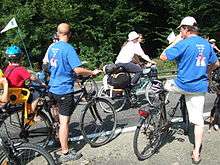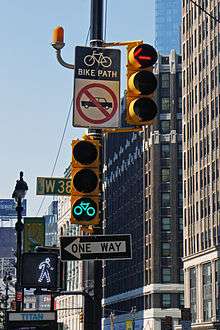Bicycle safety

Bicycle safety is the use of road traffic safety practices to reduce risk associated with cycling. Risk can be defined as the number of incidents occurring for a given amount of cycling. In many countries both the number of incidents and the amount of cycling (expressed in kilometers, hours or trips) are not well known. Non-fatal accidents often go unreported and bicycle use is only occasionally monitored.[1] Some of this subject matter is hotly debated: for example, the discussions as to whether bicycle helmets or cyclepaths really improve safety. The merits of obeying the rules of the road including the use of bicycle lighting at night are less controversial.
Crashes
The first recorded bicycle crash occurred in 1842, reportedly between Kirkpatrick McMillan, an early rider of the velocipede, and a young girl in Glasgow. The report, however, is vague and the identification disputed.[2]

Causes of crashes vary according to local conditions. A study conducted in 2000 by the Institute for Road Safety Research in the Netherlands found that single bicycle crashes accounted for 47% of all bicycle crashes, collisions with obstacles and animals accounted for 12%, and collisions with other road users accounted for 40%, with the remaining 1% having unknown or unclassified cause. Many bicycle crashes are unreported and therefore not included in official statistics. Prospective studies estimate that less than 10% of bicycle crashes are officially reported.[3]
In the United Kingdom, cyclists have half of the rate (killed and serious injury per km) of motorcyclists but eight times the rate for motorists.[4]
Even minor bicycle crashes not involving hospitalisation can incur significant costs for the cyclist and others. The Belgian SHAPES project has recently estimated the cost at 0.12 euros per kilometre cycled.[5]
A cyclist who is hit by a car is more likely to be killed than one who just falls off.[6]
Traffic engineering
History
United Kingdom
During the mid-20th century, the traffic engineering solutions were sought which eased the passage of traffic through the streets and also protected vulnerable road users.[7] In the 1940s, an influential proponent of this ideology was Herbert Alker Tripp, an assistant commissioner of London's Metropolitan Police.[7] Tripp argued in his book Town Planning and Road Traffic that: "If we could segregate pedestrians completely from the wheeled traffic, we could of course abolish pedestrian casualties".[8]
This philosophy was also pursued by Colin Buchanan; his 1963 report for the UK Government Traffic in Towns, defined future government policy[7] until the end of the century. Buchanan knew that segregation had not been proven to work for cyclists: his 1958 book Mixed Blessing said: "The meagre efforts made to separate cyclists from motor traffic have failed, tracks are inadequate, the problem of treating them at junctions and intersections is completely unsolved, and the attitude of the cyclists themselves to these admittedly unsatisfactory tracks has not been as helpful as it might have been".[9]
Appropriately designed segregated space for cyclists on arterial or interurban routes appears to reduce overall risk. In Ireland, the provision of hard shoulders on interurban routes in the 1970s reportedly resulted in a 50% decrease in accidents.[10] It is reported that the Danes have also found that separate cycle tracks lead to a reduction in rural collisions.[11]
Road design
United States
Concern over national public health and active transportation have inspired states and municipalities to rethink present traffic engineering.[12] Following the viral popularity of a video created by video game developer Nick Falbo in February 2014,[13] Dutch-style protected intersections began to gain interest with metropolitan planning organizations. By 2015, Davis, California, Salt Lake City, Utah, and Austin, Texas became the first three U.S. cities to feature protected intersections.[14]
Signage

United Kingdom
Following increased pressure from The Times "Cities Fit For Cycling" campaign and from other media in Spring 2012, warning signs are now displayed on the backs of many HGVs. These signs are directed against a common type of accident which occurs when the large vehicle turns left at a junction: a cyclist trying to pass on the nearside can be crushed against the HGV's wheels, especially if the driver cannot see the cyclist. The signs, such as the winning design of the InTANDEM road safety competition launched in March 2012, advocate extra care when passing a large vehicle on the nearside.
United States
The Federal Highway Administration has developed various bicycle signage for motorists, which have evolved over recent years.[15] Signs and signals designed exclusively for bicycles are occasionally used to denote multiple use paths and bicycle facilities.[16]
Safety equipment and strategies
Helmets
Helmet use varies from almost none in some regions to being mandatory for children to being mandatory for all cyclists. Helmets are required in most races. Helmets may help prevent head injuries, but laws that enforce helmet use have also been shown to discourage cycling.[17]
Lights
Headlights and taillights may be mounted on the bicycle or worn by the cyclist. Lights may also be mounted on the wheels.
Bicycle lights can be powered by replaceable batteries, charged to an internal battery - from a USB connection or mains - or powered by a hub dynamo that stores energy generated by the wheels.
Since cycling lights are typically of lower power than those on motor vehicles, cycling lights are ineffective unless aimed straight forward (white front light) and straight back (red rear light) and parallel to the road. Lights mounted on a belt or bag cannot be consistently aimed in this way. Therefore, in order to be effective, the lights must be securely attached to the bicycle and properly aimed. In the US, state and local ordinances usually require this.
Audible signaling
Bells or other audible signalling devices are required equipment in many jurisdictions.
Safety education
Development
United Kingdom
Primary safety education has advanced significantly through programmes such as Effective Cycling and the development of Britain's new National Standards for cycle training. In addition to technical improvements in brakes, tyres and bicycle construction generally (for example, it is now rare for a chain to snap and throw the rider when accelerating away from a stop) there are well-understood behavioural models which actively manage the risk posed by other road users.
Cycling experts such as the UK's John Franklin emphasise the importance of assertive cycling and good road positioning. Franklin advocates the use of road positions that will give cyclists a good view of the road, will make cyclists visible to other road-users, and will discourage risky behaviour by other road users; he often advocates the use of a centre-of-lane 'primary riding position' when negotiating hazards.[18]
Driver and Cyclist Education
Canada
Driver education in Canada includes training motorists to reach across their bodies when opening automobile doors to exit. This encourages the motorist to turn to get a clear view of cyclists approaching the vehicle from behind, who are at risk to be hit by an opening door.[19][note 1]
The Netherlands
As in Canada, motorists in the Netherlands are also trained to open car doors with the arm opposite to the door being opened, thus encouraging rotating the body to look back for passing cyclists.[19] This sometimes called the "Dutch Reach".
United States
Florida
The Florida Department of Transportation (FDOT), known for its "Arrive Alive" campaign for motorists in the 1970s, has since expanded into active transportation programs such as their recent "Alert Today, Alive Tomorrow" and "Put it Down" campaigns for pedestrians and cyclists.[20] Additionally, FDOT also supports statewide educational programs offering educational materials and bicycle rodeos, such as the Florida PedBike Resource Center,[21] and the University of Miami BikeSafe Program.[22]
Idaho
In April 2016, Idaho became the first U.S. state to add questions about bicycle and pedestrian safety to the state driver's license exam and educational materials. The revised exam includes a bank of 11 unique questions, of which a minimum of two are automatically generated within every 40-question DMV test.[23]
Rural safety
Direct rear impacts with cyclists are a more prominent collision type in arterial/rural road type situations. When they occur in such circumstances they are also associated with significantly increased risk of fatality. Data collated by the OECD indicates that rural locations account for 35% or more of cycling fatalities in Denmark, Finland, France, Great Britain, Japan, the Netherlands, and Spain.[24]
Overuse-related health problems
In addition to injuries from collisions and falls, cyclists can also suffer overuse injuries, such as injuries to the neck, knees, and back, and damage to nerves, blood vessels and genito-urinary systems in the weight-bearing areas in the seat and hands. Overuse injuries among cyclists are often caused or aggravated by poor bicycle fit or adjustment.
See also
- Hazards of outdoor recreation
- Outline of cycling
- Bikeway safety
- Safety in numbers
- Vehicular cycling
- Motorcycle safety
Notes
- ↑ Drivers in the Netherlands would thus open the left door of their car with their right hand since Netherlands traffic drives on the right. The left hand would be used in countries which drive on the left.
References
- ↑ Vanparijs, J; Int Panis, L; Meeusen, R; De Geus, B (2015). "Exposure measurement in bicycle safety analysis: A review of the literature". Accident Analysis & Prevention. 84: 9–19. doi:10.1016/j.aap.2015.08.007.
- ↑ "BBC - A History of the World - Object : Replica of the world's first bicycle". BBC. Retrieved July 4, 2016.
- ↑ Bas de Geus, Grégory Vandenbulcke, Luc Int Panis, Isabelle Thomas, Bart Degraeuwe, Elke Cumps, Joris Aertsens, Rudi Torfs, Romain Meeusen, A prospective cohort study on minor accidents involving commuter cyclists in Belgium, Accident Analysis & Prevention, Available online 4 November 2011, ISSN 0001-4575, 10.1016/j.aap.2011.09.045.
- ↑ "Motorcyclists have an especially poor safety record when compared to other road user groups. Their killed and serious injury (KSI) rate in the UK, per million vehicle kilometres, is approximately twice that of pedal cyclists and over 16 times that of car drivers and passengers.". Road Safety Research Report No. 54. In-depth Study of Motorcycle Accidents
- ↑ Aertsens et al. Commuting by bike in Belgium, the costs of minor accidents. Accident Analysis & Prevention, Volume 42, Issue 6, November 2010, Pages 2149-2157.
- ↑ Davis R "Death on the Streets:Cars and the Mythology of Road Safety." Leading Edge 1993
- 1 2 3 "The cost of bad design" (PDF). The Commission for Architecture and the Built Environment (CABE). 2006.
- ↑ H.A. Tripp (1942). Town Planning and Road Traffic. E. Arnold.
- ↑ Colin Buchanan (1958). Mixed Blessing. L Hill.
- ↑ The bicycle, a study of efficiency usage and safety., D.F. Moore, An Foras Forbatha, Dublin 1975
- ↑ Pedestrian Safety, Danish Roads Directorate, Copenhagen, 1998
- ↑ http://www.saferoutespartnership.org/sites/default/files/pdf/The_Final_Active_Primer.pdf
- ↑ https://vimeo.com/86721046
- ↑ http://www.peopleforbikes.org/blog/entry/four-u.s.-cities-are-racing-to-open-the-countrys-first-protected-intersecti
- ↑ http://usa.streetsblog.org/2015/09/02/share-the-road-signs-dont-work/
- ↑ http://mutcd.fhwa.dot.gov/htm/2009/part9/fig9b_04_1_longdesc.htm
- ↑ Pucher, John; Dill, Jennifer; Handy, Susan (2010). "Infrastructure, programs, and policies to increase bicycling: An international review". Preventive Medicine. 50: S106. doi:10.1016/j.ypmed.2009.07.028.
- ↑ Franklin, J. (2007). Cyclecraft, 4th ed. Norwich: TSO
- 1 2 Bryan Walsh 'Pedal push' Time (magazine) magazine, 2012-08-13
- ↑ http://www.dot.state.fl.us/safety/2A-Programs/Bicycle-Pedestrian.shtm
- ↑ http://www.t2ctt.ce.ufl.edu/NewsBot.asp?MODE=VIEW&ID=359
- ↑ http://www.alerttodayflorida.com/programs.html
- ↑ http://www.idahostatesman.com/news/local/community/boise/article71105862.html
- ↑ Figure IV.7 Pedestrian and cyclist accidents by road type. RS7:Safety of Vulnerable Road Users, Organisation for Economic Co-operation and Development, August 1998
External links
| Wikimedia Commons has media related to Cycling safety. |
- Bicycles | National Highway Traffic Safety Administration (USA)
- How to reduce the odds of a collision with other vehicle operators
- Cameras Are Cyclists’ ‘Black Boxes’ in Accidents July 20, 2012 NYT
- Bike Boxes at Traffic-Intersections in Portland Oregon, USA
- Protected Intersections for Bicyclists by Nick Falbo
- Bike Safety from Walk Bike to School (USA, SRTS)
- University of Miami BikeSafe Program Kids' Bicycle Safety and Educational Curriculum for Schools
- Mission Possible: Bike Safety from the Texas Archive of the Moving Image
- Penalty for Rule-Breaking Bicyclists: A Remedial Class July 23, 2012 NYT
- With Horns and Lasers, Fighting to Be Noticed July 24, 2013 NYT
.jpg)